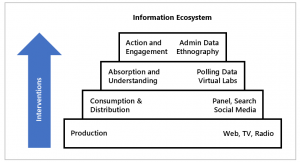Project Ratio tracks and maps the news ecosystem from start to finish: production, distribution, consumption, absorption, and impact of news. There is a lot of concern from politicians, companies, and the general population about how the news ecosystem affects public opinion, political polarization, and democracy, but getting meaningful answers requires a clear picture of the full ecosystem. This project disrupts research in this critical field by providing not only academic papers, but also the data and infrastructure to directly inform journalists, publications, and researchers of key findings, and providing these stakeholders with a platform for their own research. And, this research disrupts the market itself, giving journalists and publishers the tools they need to make better decisions.
The core mission of the Project Ratio is three-fold:
- Build a large-scale, shared data infrastructure for studying the production, distribution, consumption, absorption, and impact of news over time and across the entire information ecosystem (including the web and TV);
- Build a “many labs” research network to advance basic research and generate actionable insights that are relevant to business and public policy;
- Develop academic-industry partnerships around data and solutions, and communicate these solutions to the public.

Project Ratio enables academia and publishers to confront the full, shifting reality
- Research is currently dependent on data sets that are idiosyncratic, one-off, and often small in scale—rendering comparisons difficult across different modes of media consumption, different sample populations, and different times.
- Relevant work is scattered across several disciplines (e.g. economics, marketing, political science, communications, psychology, sociology, computer science, and network science), each with its own set of theoretical frameworks, accepted methodologies, and publishing venues. Collating and reconciling results across these disciplinary boundaries is difficult and often leads to contradictory or incoherent conclusions.
- Data is scattered between private companies and academic research: bringing that data together is both an infrastructural and cooperative challenge. Addressing these shortcomings in existing research norms and infrastructure continues to require a major effort, overcoming many obstacles, to coordinate scientific communities, data resources, and academic-industry collaborations.
Project Ratio is already making an impact in academic research and publishing communities. Academia is now able to confront the most challenging issues in the ecosystem, not just the most convenient. And by tracking the production of the news from beginning to end publishers are now given the tools to have a clearer understanding of the real impact of market forces like the absence of news, and its relative importance to fake news.

